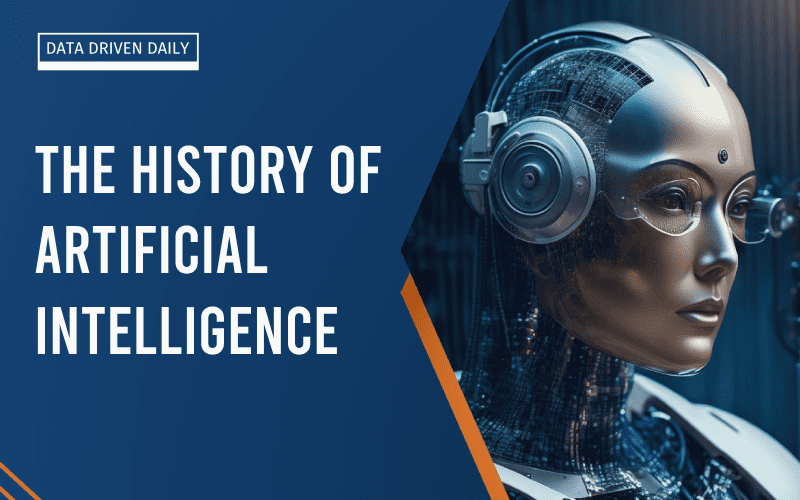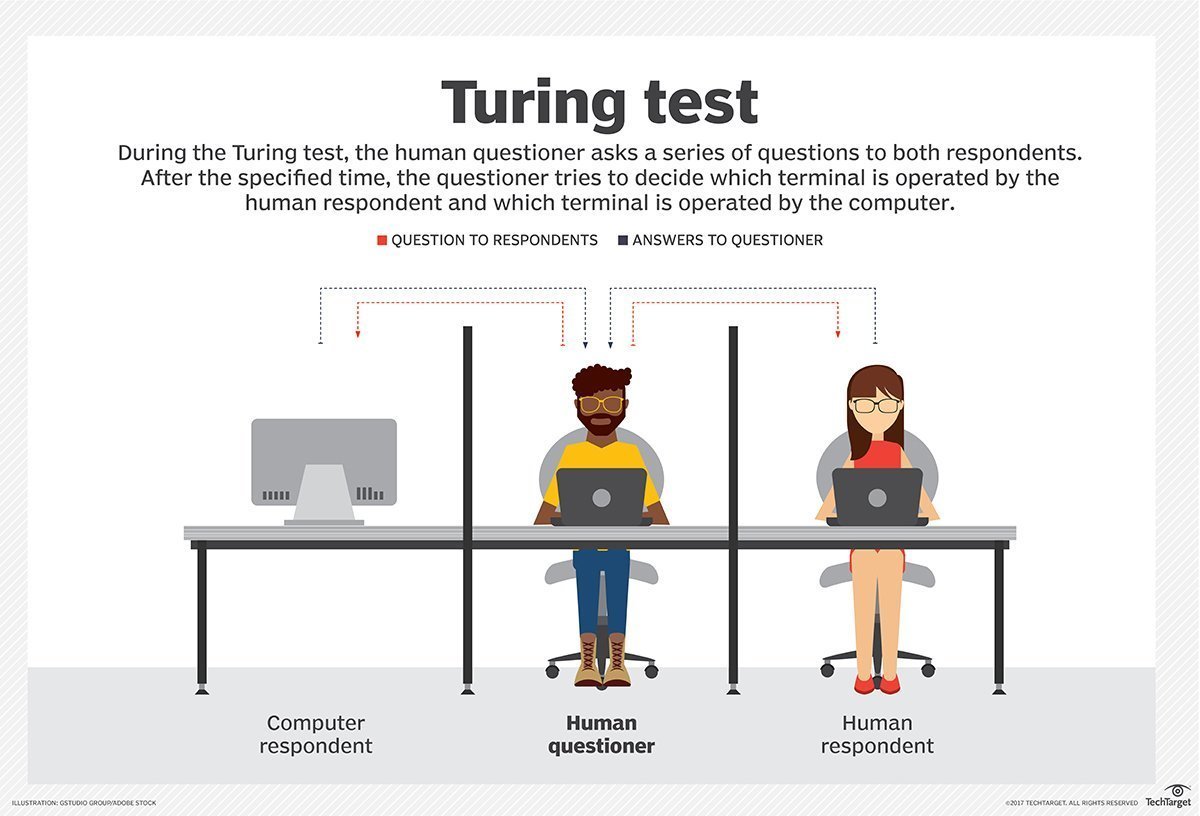If there’s one thing that continues to shape the contours of the future, it’s the relentless progression of artificial intelligence (AI).
With its roots deep in the 20th century, AI history is a fascinating tapestry of dreams, hard work, and incredible innovations.
It’s the story of humanity’s quest to create machines that not only mimic human intelligence but in some cases, even surpass it. So, let’s hop onto this time machine and traverse the labyrinth of the history of artificial intelligence.

The Dawn of the AI Era (1940s to 1950s)
Our history of artificial intelligence journey begins in the middle of the 20th century, a time of war and immense technological progression. This era was marked by seminal works that laid the groundwork for the evolution of AI. Even when computers were considered luxuries and occupied entire rooms, the ambition of AI was burgeoning.
In 1950, the brilliant mathematician and war-time code breaker, Alan Turing, introduced the concept of a machine that could think. The “Turing Test” was a revolutionary idea – a method for determining a machine’s ability to exhibit intelligent behavior equivalent to, or indistinguishable from, a human. The Turing Test became a cornerstone in AI history, a metric that we still reference when evaluating the capabilities of modern AI systems.

AI wasn’t officially birthed until 1956, when John McCarthy, an assistant professor of mathematics at Dartmouth College, decided it was time for machines to start learning. In a summer workshop at Dartmouth, McCarthy brought together top researchers to discuss “thinking machines” – a term he found too fanciful. And so, “Artificial Intelligence” was born, marking the inception of AI as a field of study and research.
Accelerating Advances (1960s to 1990s)
The next couple of decades in the history of artificial intelligence saw the torch of AI passed to a new generation of scientists and researchers, eager to build on the pioneering work of their predecessors. These AI enthusiasts were pushing boundaries, creating AI programs that could understand natural language, solve algebra problems, and even mimic the problem-solving skills of a human child.
The 1980s introduced us to expert systems, marking the first wave of AI integration in commercial applications. Companies began to see the potential of AI, adopting it for tasks like medical diagnosis, voice recognition, and data analysis. This era brought the possibilities of AI out of the labs and into the real world.
With the advent of the Internet in the 1990s, AI took a significant stride forward. The era was filled with new algorithms, like the Random Forest, Support Vector Machines, and advancements in deep learning. This was the dawn of machine learning, which served as the bedrock for the AI boom of the 21st century.
The 21st Century: AI Takes Center Stage
Fast forward to the new millennium, and we find AI taking a pivotal role in technological progress. It was in 1997 when IBM’s Deep Blue, an AI chess program, did the unthinkable and defeated world chess champion Garry Kasparov. This was a watershed moment in the history of AI, demonstrating that machines could outshine human ability in specific areas.
The 21st century bore witness to the development of revolutionary AI technologies like natural language processing, autonomous vehicles, and recommendation systems. Internet giants like Google and Amazon saw the power of AI, harnessing it to offer personalized experiences, which fundamentally altered the dynamics of the digital world.
AI in 2021: Pushing Boundaries
The start of the year brought a wave of excitement when OpenAI introduced GPT-3. Imagine having a conversation with a machine and not being able to distinguish it from a human. That’s precisely what GPT-3 offered. Capable of generating human-like text, translating languages, crafting creative content, and answering questions informatively, GPT-3 set the bar high for AI’s language understanding capabilities.
Shortly after, in March, Microsoft made a strategic move acquiring GitHub. GitHub, an already prominent platform for hosting code, also utilized AI to power its code review features. This acquisition enabled Microsoft to leverage AI in enhancing software development processes, setting a benchmark for tech companies worldwide.
As if to answer Microsoft’s move, Google announced LaMDA in May. Standing for ‘Language Model for Dialogue Applications,’ LaMDA was a milestone in the field of conversational AI. It was designed to engage in open-ended conversations on any topic, enhancing Google’s search capabilities and setting a new standard in user interaction.
AI in 2022: Innovations Galore
In February 2022, Meta (formerly Facebook) unveiled LLaMa. This AI system was engineered to generate diverse and realistic text content. From writing engaging articles to crafting appealing social media posts, LLaMa made AI-based content generation mainstream.
The following month saw Google introducing a creative text formats generator named Bard. This AI system could whip up an assortment of text formats, from poems and code scripts to musical pieces and emails. The introduction of Bard was another leap forward in AI’s capability to generate creative text.
May 2022 was marked by OpenAI’s launch of GPT-3.5. This was not just an update; it was a significant upgrade. The enhanced version of GPT-3 was larger and more powerful, further solidifying OpenAI’s place as a frontrunner in AI language model development.
AI in 2023: The Future Is Here
By 2023, the possibilities of AI were seemingly boundless. OpenAI continued to lead the pack, launching GPT-4 in January. Building on its predecessor’s strengths, GPT-4 was capable of generating even more human-like text, translating languages with greater precision, and producing a wider range of creative content. It set a new benchmark in AI’s language understanding capabilities.
Not to be outdone, Google announced the development of Meena in March. This AI system was designed to engage humans in conversations on sensitive topics with an unparalleled level of nuance and empathy. This was an important step towards creating AI systems that understand and respect human emotions.
Finally, in May, Meta announced the development of Jarvis. This AI system was designed to help people with everyday tasks, such as scheduling appointments, making reservations, and finding information. Jarvis promised a future where AI could serve as an intelligent personal assistant, seamlessly integrating into our daily lives.
Indeed, the history of AI from 2021 to 2023 is filled with breakthroughs that have pushed the boundaries of what we thought was possible. As we look forward, we can only imagine what the next chapters in AI history will bring.
The Future of AI: Promises and Predictions
As we stand on the precipice of this vast, uncharted frontier, it’s hard not to speculate about the future of AI. Will we see machines achieving consciousness, or will AI technology plateau at a certain point?
While no one can predict the future with certainty, there are a few trends and possibilities that we can explore. One such possibility is the integration of AI in every facet of our lives. AI is likely to play an increasingly prominent role in areas like healthcare,
Ben is a full-time data leadership professional and a part-time blogger.
When he’s not writing articles for Data Driven Daily, Ben is a Head of Data Strategy at a large financial institution.
He has over 12 years’ experience in Banking and Financial Services, during which he has led large data engineering and business intelligence teams, managed cloud migration programs, and spearheaded regulatory change initiatives.